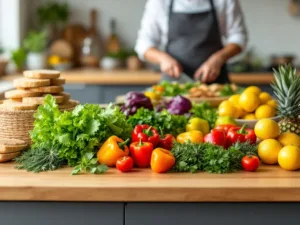How to Prepare Healthy Food Without Using Salt: A Comprehensive Guide to Flavorful, Low-Sodium Cooking
Introduction
In a world where processed foods and fast meals dominate our diets, salt has become an omnipresent ingredient. While it enhances flavor, excessive salt consumption is linked to numerous health issues, including hypertension, heart disease, and stroke. The World Health Organization (WHO) recommends consuming less than 5 grams of salt per day, yet many of us far exceed this limit. But what if you could prepare delicious, healthy meals without relying on salt? This article explores how to cook flavorful, nutritious food without compromising on taste, offering practical tips, alternative seasonings, and creative cooking techniques. Whether you’re looking to reduce your sodium intake for health reasons or simply want to explore new culinary horizons, this guide will equip you with the tools to prepare healthy, salt-free meals that delight your taste buds.
The Health Implications of Excessive Salt Consumption
Understanding the Role of Salt in Our Diets
Salt, or sodium chloride, is essential for maintaining fluid balance, nerve function, and muscle contraction. However, the modern diet often contains far more salt than our bodies need. Processed foods, restaurant meals, and even seemingly healthy snacks are frequently loaded with sodium. This overconsumption can lead to:
- High Blood Pressure: Excess sodium causes the body to retain water, increasing blood volume and pressure on artery walls.
- Heart Disease and Stroke: High blood pressure is a major risk factor for cardiovascular diseases.
- Kidney Damage: The kidneys struggle to filter excess sodium, potentially leading to chronic kidney disease.
- Osteoporosis: High sodium levels can cause calcium loss, weakening bones over time.
Why Reducing Salt Matters
Reducing salt intake is one of the simplest and most effective ways to improve overall health. By cooking at home and controlling the ingredients, you can significantly lower your sodium consumption. The challenge lies in maintaining flavor without relying on salt. Fortunately, there are countless ways to achieve this.
Building a Flavorful Foundation: Salt-Free Cooking Basics
1. Embrace Fresh Ingredients
The foundation of any great dish is high-quality, fresh ingredients. Fresh vegetables, fruits, herbs, and spices are naturally low in sodium and packed with flavor. For example:
- Vegetables: Roasted carrots, caramelized onions, and grilled zucchini offer natural sweetness and depth.
- Fruits: Citrus fruits like lemons and limes add brightness, while apples and pears can provide subtle sweetness.
- Herbs and Spices: Basil, cilantro, thyme, and rosemary are just a few examples of herbs that can elevate a dish without salt.
2. Master the Art of Seasoning
Salt is just one of many seasonings. Experiment with salt-free alternatives to create complex, satisfying flavors:
- Acidic Ingredients: Vinegars (balsamic, apple cider, red wine) and citrus juices can mimic the tanginess that salt often provides.
- Umami Boosters: Ingredients like mushrooms, tomatoes, soy sauce (low-sodium), and nutritional yeast add savory depth.
- Heat: Chili peppers, cayenne, and black pepper can add a kick that distracts from the lack of salt.
3. Use Cooking Techniques to Enhance Flavor
How you cook your food can significantly impact its taste. Consider these techniques:
- Roasting and Grilling: These methods caramelize natural sugars, intensifying flavor.
- Sautéing and Stir-Frying: Quick cooking at high heat preserves texture and enhances taste.
- Braising and Stewing: Slow cooking allows flavors to meld and deepen.
Salt-Free Pantry Essentials
Stocking your pantry with salt-free staples is key to successful low-sodium cooking. Here are some must-haves:
1. Herbs and Spices
- Dried Herbs: Oregano, basil, thyme, and dill.
- Spices: Cumin, coriander, paprika, turmeric, and cinnamon.
- Spice Blends: Create your own blends (e.g., Italian seasoning, curry powder) to avoid store-bought mixes that often contain salt.
2. Condiments and Sauces
- Vinegars: Balsamic, red wine, rice, and apple cider vinegar.
- Mustard: Dijon or whole-grain mustard (check labels for salt content).
- Hot Sauce: Many brands offer low-sodium options.
- Soy Sauce Alternatives: Coconut aminos or low-sodium soy sauce.
3. Grains and Legumes
- Whole Grains: Quinoa, brown rice, and farro.
- Legumes: Lentils, chickpeas, and black beans (opt for no-salt-added varieties).
4. Nuts and Seeds
- Unsalted Nuts: Almonds, walnuts, and cashews.
- Seeds: Flaxseeds, chia seeds, and sesame seeds.
Creative Salt-Free Recipes and Ideas
1. Breakfast: Herb-Infused Avocado Toast
- Ingredients: Whole-grain bread, ripe avocado, lemon juice, black pepper, fresh herbs (parsley, cilantro, or dill).
- Method: Mash the avocado with lemon juice and herbs, spread on toasted bread, and sprinkle with black pepper.
2. Lunch: Mediterranean Quinoa Salad
- Ingredients: Cooked quinoa, cherry tomatoes, cucumber, red onion, Kalamata olives, feta cheese (optional), olive oil, lemon juice, oregano.
- Method: Toss all ingredients together and drizzle with olive oil and lemon juice.
3. Dinner: Lemon-Garlic Herb Chicken with Roasted Vegetables
- Ingredients: Chicken breasts, garlic, lemon zest, thyme, rosemary, olive oil, assorted vegetables (carrots, broccoli, bell peppers).
- Method: Marinate chicken in garlic, lemon zest, and herbs, then bake alongside roasted vegetables.
4. Snack: Spiced Roasted Chickpeas
- Ingredients: Canned chickpeas (no salt added), olive oil, cumin, paprika, garlic powder.
- Method: Toss chickpeas with oil and spices, then roast until crispy.
Practical Tips for Reducing Salt in Your Diet
1. Read Labels Carefully
Processed foods are the primary source of dietary sodium. Always check nutrition labels for sodium content and opt for low-sodium or no-salt-added versions.
2. Cook at Home
Preparing meals at home gives you complete control over ingredients and seasoning. Start with simple recipes and gradually experiment with new flavors.
3. Gradually Reduce Salt
If you’re used to salty foods, your taste buds may need time to adjust. Gradually reduce the amount of salt in your recipes and increase the use of herbs and spices.
4. Rinse Canned Foods
Canned beans, vegetables, and soups often contain added salt. Rinse them thoroughly before use to remove excess sodium.
5. Use Salt Substitutes Wisely
While salt substitutes (e.g., potassium chloride) can be helpful, they may not suit everyone, especially those with kidney issues. Consult a healthcare professional before using them.
Conclusion: Embracing a Salt-Free Lifestyle
Reducing salt in your diet doesn’t mean sacrificing flavor. By embracing fresh ingredients, experimenting with herbs and spices, and mastering cooking techniques, you can create delicious, healthy meals that satisfy your palate and support your well-being. Start small, be patient with your taste buds, and enjoy the journey of discovering new flavors. Remember, healthy eating is not about deprivation—it’s about making mindful choices that nourish your body and soul. So, grab your apron, explore the world of salt-free cooking, and savor the vibrant tastes of a healthier lifestyle.









Add comment